Observation of Aircraft Wake Vortex Evolution under Crosswind Conditions by Pulsed Coherent Doppler Lidar
Abstract
:1. Introduction
2. Experiments and Methodology
2.1. Experiments
2.1.1. Wake Vortex Observation Experiments
2.1.2. Pulse Coherent Doppler Lidar System (PCDL)
2.1.3. Scanning Strategy Design
2.2. Methodology
2.2.1. Wake Vortex Core Position Identification Method
2.2.2. Retrieval of the Ambient Wind Field
3. Results and Discussion
3.1. Characteristics of the Radial Velocity Distribution of Wake Vortex with and without Crosswind
3.2. Analysis of Wake Vortex Trajectories with and without Crosswind
3.3. Analysis of Wake Vortex Trajectories under Various Crosswind Conditions
4. Conclusions
Author Contributions
Funding
Institutional Review Board Statement
Informed Consent Statement
Data Availability Statement
Acknowledgments
Conflicts of Interest
References
- Wu, Y.; Hu, Y.; Xu, S.; Li, J.; Dai, D. Design of airport wake vortex monitoring system based on 1.5-μm pulsed coherent Doppler lidar. Optoelectron. Lett. 2011, 7, 298–303. [Google Scholar] [CrossRef]
- Wu, S.; Zhai, X.; Liu, B. Aircraft wake vortex and turbulence measurement under near-ground effect using coherent Doppler lidar. Opt. Express 2019, 27, 1142–1163. [Google Scholar] [CrossRef]
- Rossow, V.J. Lift-generated vortex wakes of subsonic transport aircraft. Prog. Aerosp. Sci. 1999, 35, 507–660. [Google Scholar] [CrossRef]
- Holzäpfel, F.; Dengler, K.; Gerz, T.; Schwarz, C. Prediction of dynamic pairwise wake vortex separations for approach and landing. In Proceedings of the 3rd AIAA Atmospheric Space Environments Conference, Honolulu, HI, USA, 27–30 June 2011. [Google Scholar] [CrossRef] [Green Version]
- Holzäpfel, F.; Kladetzke, J. Assessment of Wake-Vortex Encounter Probabilities for Crosswind Departure Scenarios. J. Aircr. 2011, 48, 812–822. [Google Scholar] [CrossRef] [Green Version]
- Frehlich, R.; Sharman, R. Maximum Likelihood Estimates of Vortex Parameters from Simulated Coherent Doppler Lidar Data. J. Atmos. Ocean. Technol. 2005, 22, 117–130. [Google Scholar] [CrossRef]
- Holzäpfel, F. Probabilistic Two-Phase Wake Vortex Decay and Transport Model. J. Aircr. 2003, 40, 323–331. [Google Scholar] [CrossRef] [Green Version]
- Hallock, J.N.; Greene, G.C.; Burnham, D.C. Wake Vortex Research—A Retrospective Look. Air Traffic Control. Q. 1998, 6, 161–178. [Google Scholar] [CrossRef]
- Liu, Z.; Barlow, J.F.; Chan, P.-W.; Fung, J.C.H.; Li, Y.; Ren, C.; Mak, H.W.L.; Ng, E. A Review of Progress and Applications of Pulsed Doppler Wind LiDARs. Remote Sens. 2019, 11, 2522. [Google Scholar] [CrossRef] [Green Version]
- Winckelmans, G.; Cocle, R.; Dufresne, L.; Capart, R. Vortex methods and their application to trailing wake vortex simulations. Comptes Rendus Phys. 2005, 6, 467–486. [Google Scholar] [CrossRef]
- Holzäpfel, F.; Hofbauer, T.; Darracq, D.; Moet, H.; Garnier, F.; Gago, C.F. Analysis of wake vortex decay mechanisms in the atmosphere. Aerosp. Sci. Technol. 2003, 7, 263–275. [Google Scholar] [CrossRef]
- Köpp, F. Doppler lidar investigation of wake vortex transport between closely spaced parallel runways. AIAA J. 1994, 32, 805–810. [Google Scholar] [CrossRef]
- Brandon, J.M.; Stuever, R.A.; Buttrill, C.W. Application of Wind Tunnel Free-Flight Technique for Wake Vortex Encounters. In NASA Technical Paper; National Aeronautics and Space Administration Langley Research Center: Hampton, VA, USA, 1997; p. 3672. [Google Scholar]
- Köpp, F.; Rahm, S.; Smalikho, I. Characterization of Aircraft Wake Vortices by 2-μm Pulsed Doppler Lidar. J. Atmos. Ocean. Technol. 2004, 21, 194–206. [Google Scholar] [CrossRef]
- Smalikho, I.N.; Banakh, V.A.; Holzäpfel, F.; Rahm, S. Method of radial velocities for the estimation of aircraft wake vortex parameters from data measured by coherent Doppler lidar. Opt. Express 2015, 23. [Google Scholar] [CrossRef] [PubMed] [Green Version]
- Hallermeyer, A.; Dolfi-Bouteyre, A.; Valla, M.; Brusquet, L.L.; Fleury, G.; Thobois, L.P.; Cariou, J.-P.; Duponcheel, M.; Winckelmans, G. Development and assessment of a Wake Vortex characterization algorithm based on a hybrid LIDAR signal processing. In Proceedings of the 8th AIAA Atmospheric and Space Environments Conference, Washington, DC, USA, 13–17 June 2016. [Google Scholar] [CrossRef] [Green Version]
- Breitsamter, C. Wake vortex characteristics of transport aircraft. Prog. Aerosp. Sci. 2011, 47, 89–134. [Google Scholar] [CrossRef]
- Holzäpfel, F.; Misaka, T.; Hennemann, I. Wake-Vortex Topology, Circulation, and Turbulent Exchange Processes. In Proceedings of the AIAA Atmospheric and Space Environments Conference, Toronto, ON, Canada, 2–5 August 2010. [Google Scholar] [CrossRef] [Green Version]
- Körner, S.; Holzäpfel, F. Assessment of the Wake-Vortex Proximity to Landing Aircraft Exploiting Field Measurements. J. Aircr. 2019, 56, 1250–1258. [Google Scholar] [CrossRef]
- Hallock, J.N.; Holzäpfel, F. A review of recent wake vortex research for increasing airport capacity. Prog. Aerosp. Sci. 2018, 98, 27–36. [Google Scholar] [CrossRef]
- Proctor, F.H.; Ahmad, N.N.; Switzer, G. Crosswind Shear Gradient Affect on Wake Vortices. In Proceedings of the 3rd AIAA Atmospheric Space Environments Conference, Honolulu, HI, USA, 27–30 June 2011. [Google Scholar] [CrossRef] [Green Version]
- Frech, M.; Zinner, T. Concept of Wake Vortex Behavior Classes. J. Aircr. 2004, 41, 564–570. [Google Scholar] [CrossRef]
- Dengler, K.; Holzäpfel, F.; Gerz, T.; Wiegele, A.; Visscher, I.D.; Winckelmans, G.; Bricteux, L.; Fischer, H.; Konopka, J. Crosswind thresholds supporting wake-vortex-free corridors for departing aircraft. Meteorol. Appl. 2012, 19, 289–301. [Google Scholar] [CrossRef] [Green Version]
- Kauertz, S.; Holzäpfel, F.; Kladetzke, J. Wake Vortex Encounter Risk Assessment for Crosswind Departures. J. Aircr. 2012, 49, 281–291. [Google Scholar] [CrossRef]
- Paramasivam, S.; Skote, M.; Dan, Z.; Schluter, J.U. Detailed Study of Effects of Crosswind and Turbulence Intensity on Aircraft Wake-Vortex in Ground Proximity. In Proceedings of the American Institute of Aeronautics and Astronautics, Washington, DC, USA, 13–17 June 2016. [Google Scholar] [CrossRef] [Green Version]
- Holzäpfel, F.; Tchipev, N.; Stephan, A. Wind impact on single vortices and counterrotating vortex pairs in ground proximity. FlowTurbul. Combust. 2016, 97, 829–848. [Google Scholar] [CrossRef]
- Holzäpfel, F.; Steen, M. Aircraft Wake-Vortex Evolution in Ground Proximity: Analysis and Parameterization. AIAA J. 2007, 45, 218–227. [Google Scholar] [CrossRef] [Green Version]
- Wu, S.; Liu, B.; Liu, J.; Zhai, X.; Feng, C.; Wang, G.; Zhang, H.; Yin, J.; Wang, X.; Li, R.; et al. Wind turbine wake visualization and characteristics analysis by Doppler lidar. Opt. Express 2016, 24. [Google Scholar] [CrossRef] [PubMed]
- Zhang, H.; Wu, S.; Wang, Q.; Liu, B.; Yin, B.; Zhai, X. Airport low-level wind shear lidar observation at Beijing Capital International Airport. Infrared Phys. Technol. 2019, 96, 113–122. [Google Scholar] [CrossRef] [Green Version]
- Gao, H.; Li, J.; Chan, P.W.; Hon, K.K.; Wang, X. Parameter-retrieval of dry-air wake vortices with a scanning Doppler Lidar. Opt. Express 2018, 26, 16377–16392. [Google Scholar] [CrossRef] [PubMed]
- Li, J.; Shen, C.; Gao, H.; Chan, P.W.; Hon, K.K.; Wang, X. Path integration (PI) method for the parameter-retrieval of aircraft wake vortex by Lidar. Opt. Express 2020, 28, 4286–4306. [Google Scholar] [CrossRef] [PubMed]
- Rahm, S.; Smalikho, I. Aircraft wake vortex measurement with airborne coherent Doppler lidar. J. Aircr. 2008, 45, 1148–1155. [Google Scholar] [CrossRef] [Green Version]
- Wu, S.; Zhai, X.; Liu, B.; Liu, J. Characterization of aircraft dynamic wake vortices and atmospheric turbulence by coherent doppler lidar. EPJ Web Conf. 2018, 176, 6001. [Google Scholar] [CrossRef]
- Smalikho, I.; Köpp, F.; Rahm, S. Measurement of Atmospheric Turbulence by 2-μm Doppler Lidar. J. Atmos. Ocean. Technol. 2005, 22, 1733–1747. [Google Scholar] [CrossRef]


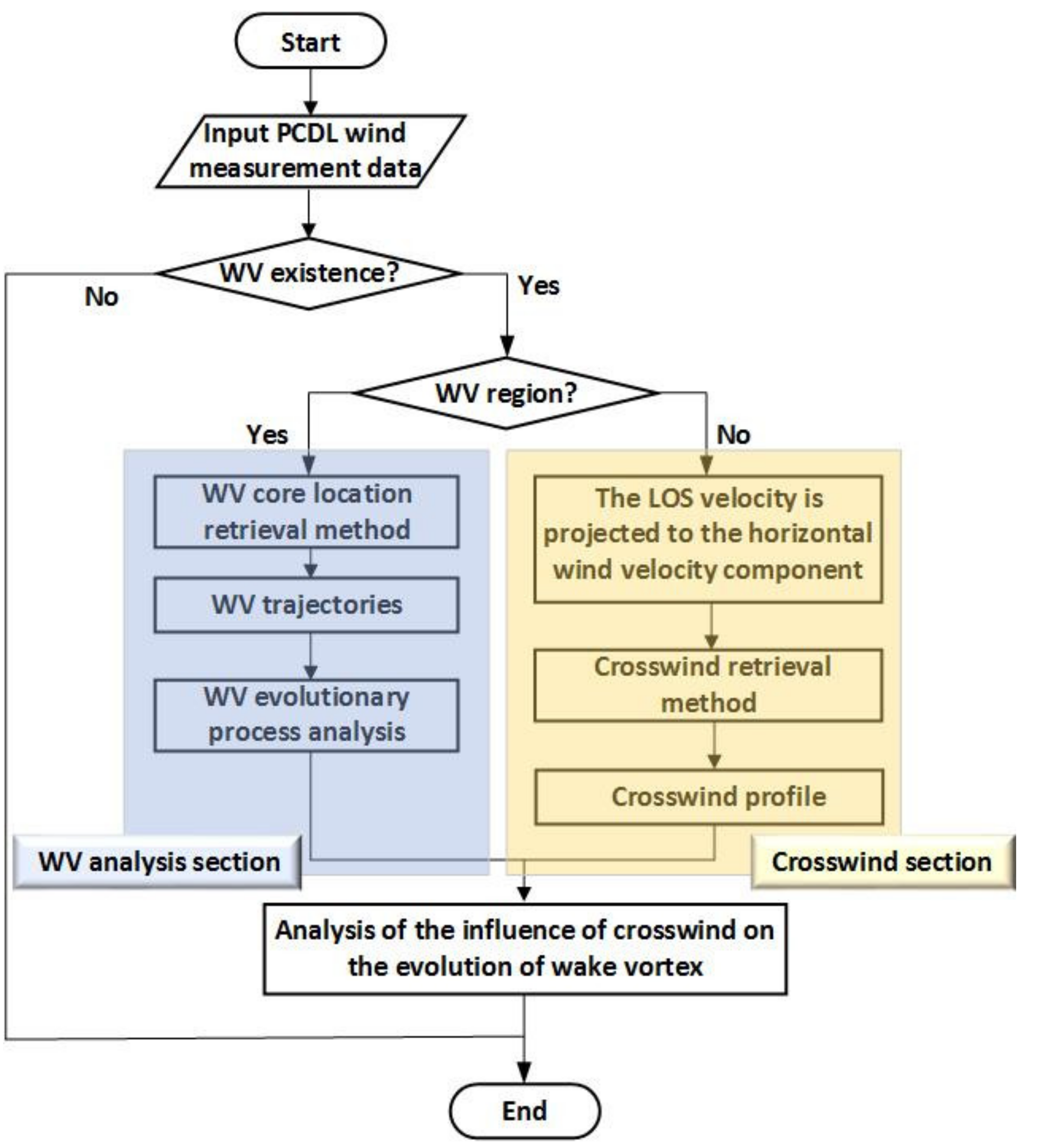
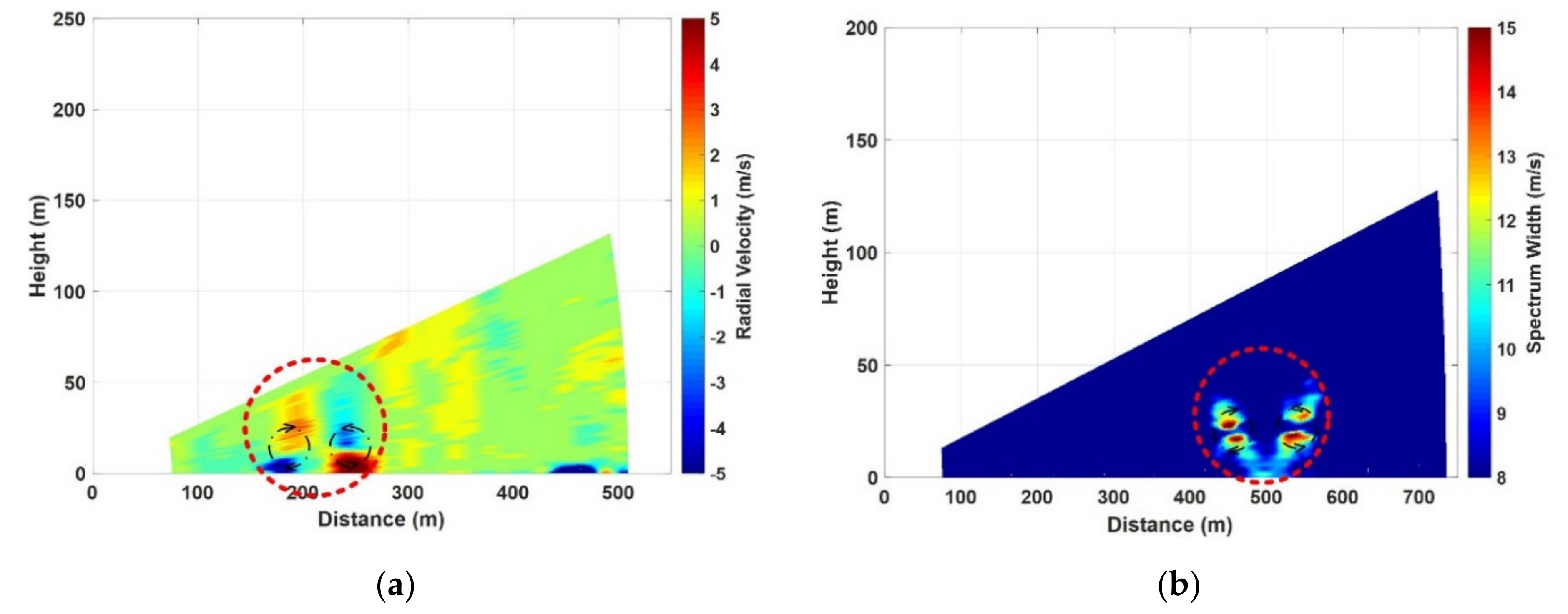
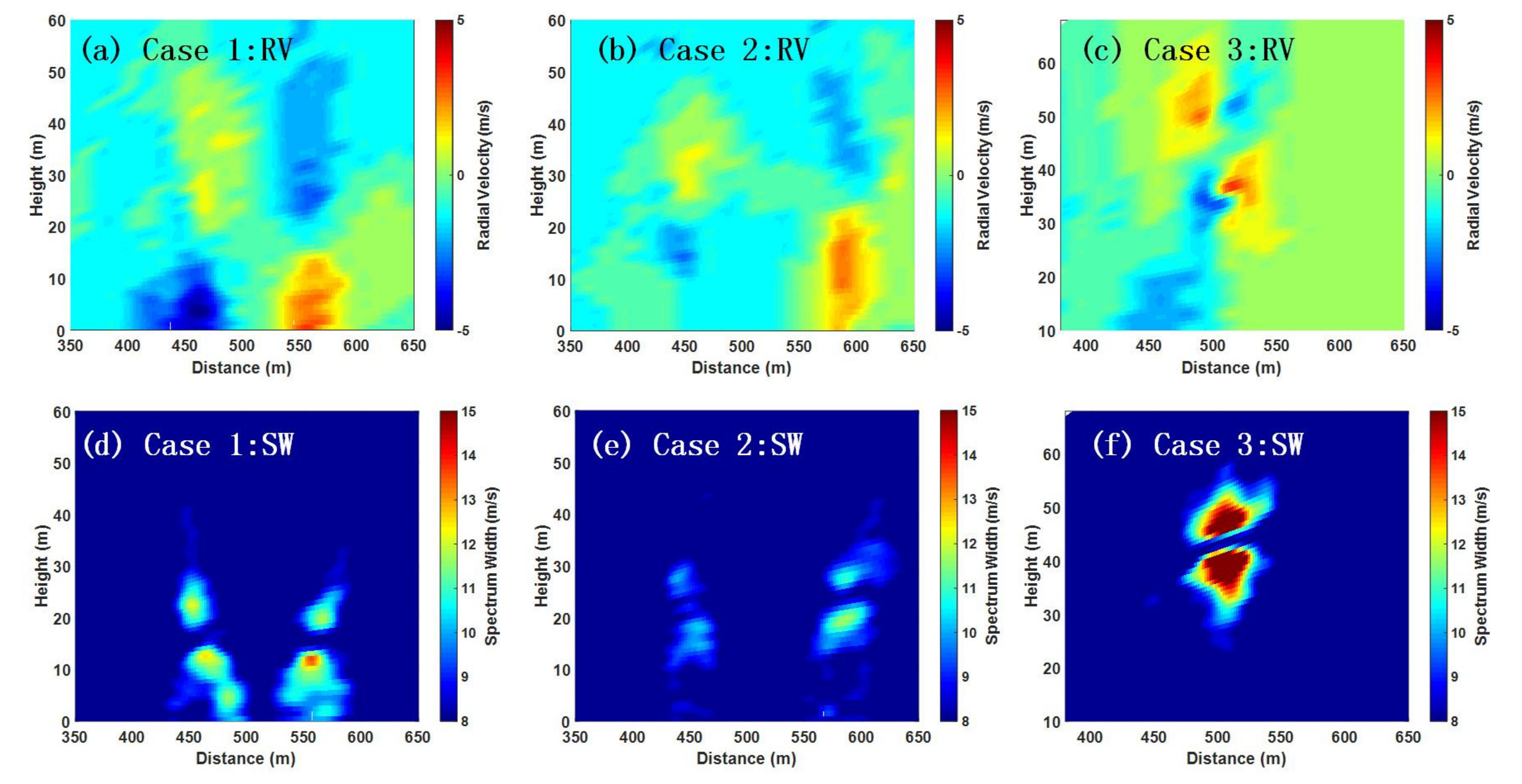

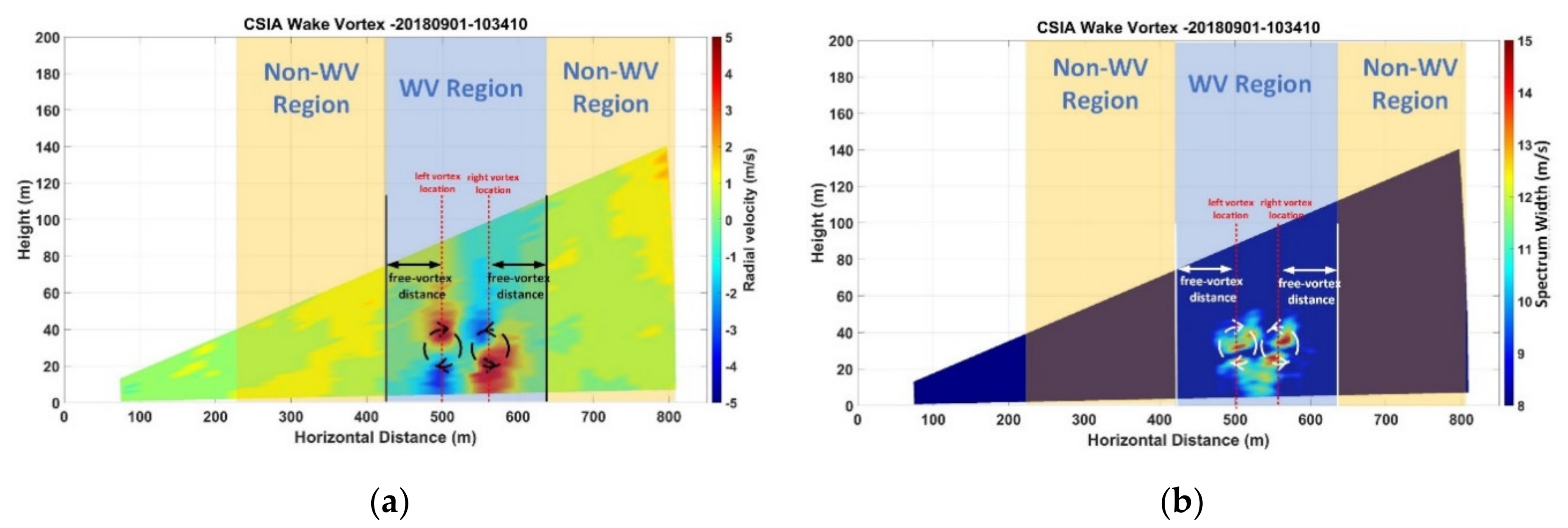
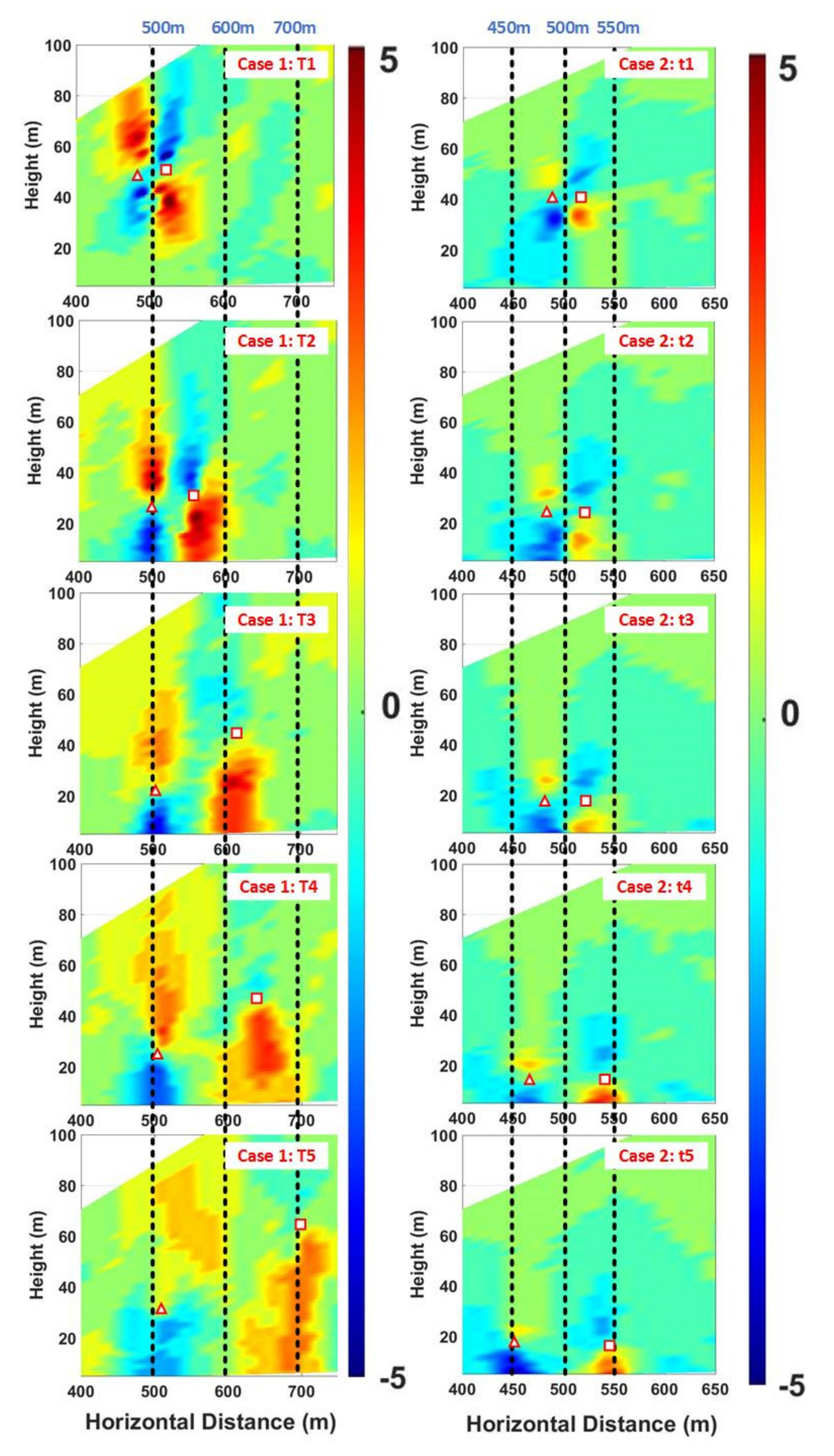



| No. | Airport | Experimental Date | Take-Off/Landing |
|---|---|---|---|
| 1 | MNA | 6–21 August 2018 | Take-off |
| 2 | CSIA | 25 August–20 September 2018 | Landing |
| 3 | CSIA | 21 September–22 October 2018 | Take-off |
| Parameter | Specification |
|---|---|
| Wavelength | 1.55 μm |
| Pulse repetition frequency | 10 kHz |
| Pulse width | 100 ns~400 ns |
| Pulse energy | 150 μJ |
| Measurement range | 45 m~6000 m |
| Range resolution | 15 m~60 m |
| Velocity measurement uncertainty | ≤0.1 m/s |
| Radial velocity measurement range | −37.5 m/s~+37.5 m/s 1 |
| Data update rate | 1 Hz~10 Hz |
| Sampling rate | 1 GHz |
| Power Consumption | <300 W |
| Weight | ~75 kg |
| Parameter | Specification |
|---|---|
| Elevation angle resolution | 0.1°~0.4° |
| Scanning speed | 1°/s~2°/s |
| Longitudinal size of effective probing volume | 27 m |
| Scan duration | 10 s~20 s |
| Elevation angle range | 0°~25° (take-off, MNA) |
| 0°~10° (landing, CSIA) | |
| 5°~25° (take-off, CSIA) |
Publisher’s Note: MDPI stays neutral with regard to jurisdictional claims in published maps and institutional affiliations. |
© 2020 by the authors. Licensee MDPI, Basel, Switzerland. This article is an open access article distributed under the terms and conditions of the Creative Commons Attribution (CC BY) license (http://creativecommons.org/licenses/by/4.0/).
Share and Cite
Liu, X.; Zhang, X.; Zhai, X.; Zhang, H.; Liu, B.; Wu, S. Observation of Aircraft Wake Vortex Evolution under Crosswind Conditions by Pulsed Coherent Doppler Lidar. Atmosphere 2021, 12, 49. https://doi.org/10.3390/atmos12010049
Liu X, Zhang X, Zhai X, Zhang H, Liu B, Wu S. Observation of Aircraft Wake Vortex Evolution under Crosswind Conditions by Pulsed Coherent Doppler Lidar. Atmosphere. 2021; 12(1):49. https://doi.org/10.3390/atmos12010049
Chicago/Turabian StyleLiu, Xiaoying, Xinyu Zhang, Xiaochun Zhai, Hongwei Zhang, Bingyi Liu, and Songhua Wu. 2021. "Observation of Aircraft Wake Vortex Evolution under Crosswind Conditions by Pulsed Coherent Doppler Lidar" Atmosphere 12, no. 1: 49. https://doi.org/10.3390/atmos12010049
APA StyleLiu, X., Zhang, X., Zhai, X., Zhang, H., Liu, B., & Wu, S. (2021). Observation of Aircraft Wake Vortex Evolution under Crosswind Conditions by Pulsed Coherent Doppler Lidar. Atmosphere, 12(1), 49. https://doi.org/10.3390/atmos12010049





